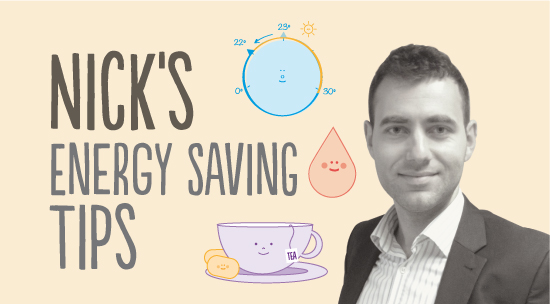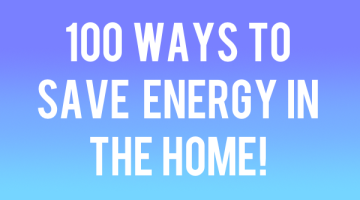
Top ways to save on your energy bills if you have some money to invest!
Unfortunately not all energy saving measures are free – so while previously we showed you how to save on your energy bills with little to no investment, this week we are going to have a look at the top ways if you do have a bit of cash handy to invest. This final guide therefore looks at the more expensive solutions, which although cost a little more, are sure to make the biggest difference on your energy bills.
Why let hot air escape through your roof?
Heat loss in the home is much like the heat loss that occurs in you or me. You wouldn’t go outside in the cold without a hat on, so why wouldn’t you insulate your roof.
All of you Yorkshire folk out there certainly know the importance of putting on a hat before leaving the house ‘On Ilkley moor bah tat’.
Insulating your loft is, compared to the savings that it creates, one of the cheapest ways to dramatically reduce your energy bills. In an un-insulated home as much of 25% of the heat escapes via the roof space. Insulation provides a thermal barrier that dramatically slows down this loss of heat and is an easy DIY solution.
From £7.46 per square meter
Create your own electricity with Solar PV panels
Over the last couple of years, the cost of installing Solar PV panels has basically halved – so you should be able to get a 3.5kW system installed on your roof for about £6,500.
This massive fall in price is due to increased competition and economies of scale in China where they have built huge solar PV manufacturing facilities.
The reason for solar PV being so worthwhile is that it is backed by a Government incentive known as the Feed-in Tariff, which rewards those who install solar PV by paying them a fixed price for every kWh of electricity produced – regardless of whether the electricity is used in the home or sold back to the grid.
As a rough guide a 3.5kW system should produce about 2,900 kWh of electricity per year – which should help provide about half the electricity for a normal sized home.
That means that Solar PV systems are a win, win situation, since they provide both a steady stream of income as well as your own free electricity.
Are your walls cold to touch? – if so you are most likely losing heat through them!
Cold walls generally mean that you are losing lots of heat through them.
Up to 35% of all heat loss that takes place in the home occurs through the walls.
Combatting this depends slightly on the type of walls you have in your home – cavity walls need cavity wall insulation, while solid walls are going to need either internal or external insulation (which is done by adding rigid insulating boards to either the inside or outside of the wall and then rendering them).
If you are looking for a slightly simpler way to insulate your walls – you can use Wallrock Thermal liner.
Although Wallrock Thermal Liner is not as efficient as internal wall insulation, at only 4mm thick, it only minimally reduces the size of your room. This makes it perfect for smaller properties where space is at a premium and also it can be easily installed as a DIY job, much like wallpaper, by using Wallrock adhesive.
Electric or oil based heaters may not be the most efficient way to warm your home
Traditional Electric or oil-based heaters are definitely not the most efficient way to provide supplementary heat around the home, instead you should look no further than Infrared heating panels.
Where conventional electric heaters use convection to warm rooms, infrared panels use infrared radiation (much like how we are warmed by the sun even on the coldest of days). This infrared heating system requires less electricity to provide similar amounts of warmth. Therefore infrared panels are a much more efficient way to heat your home.
One of the main benefits of the infrared panels is their ability to warm cold spots in your home. Infrared panels are easily installed on either you ceiling or your wall and can prevent damp from forming as well as eliminating mould.
If you suffer from allergies, then Infrared heating panels are the best solution. Traditional convection heating systems continuously circulate allergens throughout the room. However, because infrared heaters use radiation, there is no need for air to be circulated to such an extent as to disturb dust, pollen and other bits and bobs that may bring about sneezing and asthma.
Infrared heating panels can be used as complete central heating systems or as additional single room heaters in homes, extensions, garden rooms and conversions.
Fed up of paying through the roof? Shift to Biomass
Much like you conventional oil or gas based boilers, biomass boilers also provide your house with heat and hot water. However, instead of relying on unsustainable fuel sources imported from around the world, they are fuelled using sustainably sourced wood pellets.
This carbon neutral fuel, not only provides a more environmentally friendly way of fuelling your boiler, but also a cheaper way. Priced at around 2.9 p/kWh compared with 4.8 p/kWh, it is clear how much you could save in the long run.
While the running costs are cheap, the large capital upfront cost can often dissuade people to research further. However, two governmental initiatives have been brought in increase the popularity of renewables. The first is the RHPP, which comes in the shape of a voucher to help you pay the initial upfront capital cost of the Biomass boiler. Secondly, the RHI (renewable heat incentive), which pays 12.2 p/kWh generated, payable for 7 years.
For a typical home where the energy requirement for heating is 20,000kWh then this would result in a yearly payment in excess of £2,500 – which very quickly would cover the cost of the new boiler.
Before installing a biomass boiler – we recommend speaking to a professional installer to ensure its suitability in your home, but to learn more about biomass boilers please click here.











No Comments yet! Be the first one.